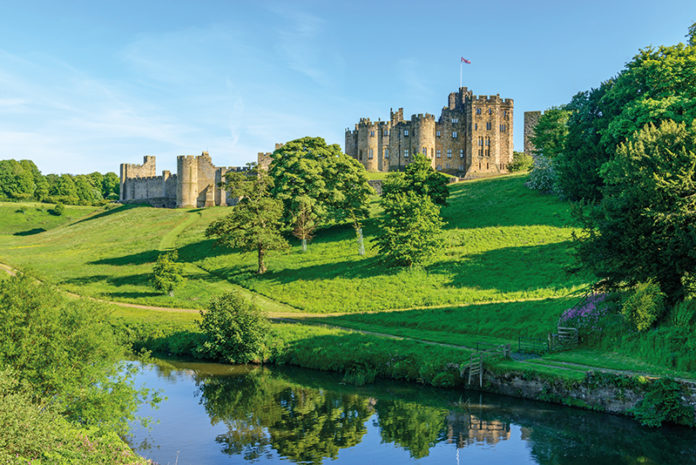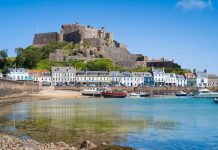Northumberland is home to more castles than any other English county. We travel to England’s northernmost region to hear tales of theft, murder and spooky apparitions
Its location close to the Scottish border has meant that Northumberland has suffered a turbulent past, with pillaging from Border Reivers in the late Middle Ages and the constant threat of invading armies. For protection, Northumbrians built huge fortresses and today 70 or more of these castles dot the wild landscape, from haunting ruins to imposing palaces.
Very much a buffer between Scotland and England, Northumberland was first subjected to raids from the Vikings. Later, the bloody border wars saw Scottish kings capture castles and ravage the countryside. Berwick-upon-Tweed, just three miles from the Scottish border, has changed hands between the English and Scottish 13 times. It has been in English territory since 1482.
Berwick Castle
There’s not much left of medieval Berwick Castle, but the fortifications, which were added in the 16th century and updated in the 17th century, encircle the whole town and are seriously impressive. Take time to walk the complete circuit and look out for the Grade I listed Royal Border Bridge that spans the River Tweed. Designed by Robert Stephenson (son of ‘Father of the Railways’, George Stephenson), it includes 28 semi-circular arches and gently curves across the water to stunning effect.
Lindisfarne Castle
The prize for the most atmospheric castle in Northumberland must go to Lindisfarne, which sits on its own island and is accessible on foot at low tide. Sitting on a volcanic crag, Lindisfarne Castle (on the Holy Isle) is built on the site of a 7th-century monastery, founded by St Aidan and later presided over by St Cuthbert.
It was here in 793 that a raid on the monastery sent shockwaves through Europe as the Vikings unleashed an unprecedented attack on the sacred heart of the Northumbrian kingdom. The attack, which marked the start of a relentless campaign in England by the Vikings, was recorded at Lindisfarne in the 9th and 10th centuries in a religious sculpture known as the Domesday Stone, now displayed in Lindisfarne’s museum.
The castle was built during the reign of Henry VIII and was later developed in the Elizabethan era. Unlike many of Northumberland’s castles, Lindisfarne saw little action, being seized just once in 1715 during the Jacobite risings by supporters of James Stuart, the Old Pretender. It was soon recaptured. This spring Lindisfarne reopens following 18 months of restoration work. Marking the reopening is an installation by Turner-Prize-nominated artist Anya Gallaccio. Gallaccio was inspired by Gertrude Jekyll’s colourful geometric walled garden. Gertrude Jekyll created the garden in the early 20th century when her close friend, the Arts & Crafts pioneer Edwin Lutyens, was employed to turn Lindisfarne into a holiday home for Edward Hudson, the owner of Country Life magazine.
Bamburgh Castle
Back on the mainland, about 15 miles south of Lindisfarne, Bamburgh Castle is a beautifully restored fortress that was once the Royal Seat of the Kings of Northumbria and has been a family home since 1894.
A castle has stood guard over this stretch of coastline for more than 1,400 years, but it was with the arrival of the Saxons that it became one of the most significant sites in medieval England: a royal palace that numbered St Aidan, St Cuthbert and St Oswald among its guests.
In fact, the latter two are forever connected to the castle due to an enduring legend. The story goes that following the death of St Oswald, Cuthbert sent an old man to retrieve his head from Bamburgh. Oswald’s head was supposedly returned to Lindisfarne where it was kept as a relic for some time before being found in St Cuthbert’s coffin when it was opened in the 19th century.
Today, the castle displays the results of a thorough 18th-century restoration, and there are 14 State Rooms to explore, connected by a series of intriguing stairwells, corridors and passages.
Chillingham Castle
Just 13 miles inland of Bamburgh is 13th-century Chillingham Castle, which occupied a strategic position during the border wars. Its long list of royal guests includes King Henry III, Edward I and Charles I, who stayed here for three nights before he was imprisoned.
Chillingham’s medieval design remains spookily intact, fuelling the imaginations of visitors to what is supposedly Britain’s most haunted castle. Visitors report hearing the voices of two men in the chapel beside the Great Hall, while the pale figure of a lone woman that appears in the Inner Pantry is known as the White Pantry Ghost.
Perhaps most chilling of all is the ghost in the chamber, which is never seen but rather felt in the creepy and oppressive atmosphere. Ghost tours take place throughout the year.
Dunstanburgh Castle
Standing on a remote headland, it’s hard not to feel a sense of poignancy when you visit the remains of Dunstanburgh Castle. Dunstanburgh was built in 1313 by one of King Edward II’s most powerful barons, Earl Thomas of Lancaster at a time when relations between himself and the king had soured.
Lancaster may have built the castle as an act of open defiance against the king, rather than as a military stronghold. Whatever his thinking, when he later mounted a rebellion against the king he was captured and executed. The castle was also the scene of much bloodshed during the War of the Roses, twice being captured by Yorkists and later falling into ruin.
The best way to view the castle is on a coastal walk from the quaint fishing village of Craster – which also gives you the chance to sample their famous kippers (still prepared in the traditional oak-smoked barrels).
Alnwick Castle
A few miles south of Dunstanburgh inland lies a true majesty of castles: Alnwick, which withstood numerous sieges in its history, not least when it was captured by King David I of Scotland in 1136. Originally a Norman motte and bailey castle, Alnwick has evolved beautifully over the years, most significantly in the 18th century when it was transformed from a decaying fortress into a splendid palace. However, the high Gothic style was later replaced with a more authentic looking medieval border.
Alnwick has been the family seat of the Duke of Northumberland for centuries, and its current guise has earned it starring roles in two Christmas specials of Downton Abbey (as Brancaster Castle) and two Harry Potter films. Standout features include the Outer Bailey where Harry learned the rules of Quidditch in Harry Potter and the Philosopher’s Stone, and one of the best surviving barbicans (the outer defence of a castle or wall city) in Britain. Alnwick is also the second largest inhabited castle in England (after Windsor), and it takes a commanding position over the River Aln. Thank goodness King John’s order to demolish it in 1212, as revenge against a supposed plotter, was ignored.
Wherever you go in Northumberland the sense of history is palpable, but while these magnificent fortresses were once scenes of violence and twisted in fighting, today they are serene places to visit that offer a glimpse into the region’s unsettled past.
BOOK AHEAD
Berwick Castle
English Heritage looks after the castle ruins and rampart. Make sure you walk the town walls.
www.english-heritage.org.uk
Lindisfarne Castle
The atmospheric castle on Holy Isle finally reopens this spring after an 18-month renovation project.
www.nationaltrust.org.uk/lindisfarne-castle
Bamburgh Castle
Known as the King of Castles, Bamburgh is both an imposing fortress and family home.
www.bamburghcastle.com
Chillingham Castle
Considered the most haunted castle in Britain, visit Chillingham if you dare. You can even stay over if you don’t mind things going bump in the night.
www.chillingham-castle.com
Dunstanburgh Castle
The coastal walk from Craster to Dunstanburgh is well worth doing – look out for migrating birds en route.
www.nationaltrust.org.uk/dunstanburgh-castle
Alnwick Castle
The family seat of the Duke of Northumberland is the perfect place to channel your inner Harry Potter, or earl or countess.
www.alnwickcastle.com






 © 2024
© 2024